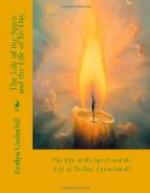I am aware that much which I am going to advocate will sound fantastic; and that the changes involved may seem at first sight impossible to accomplish. It is true that if these changes are to be useful, they must be gradual. The policy of the “clean sweep” is one which both history and psychology condemn. But it does seem to me a good thing to envisage clearly, if we can, the ideal towards which our changes should lead. A garden city is not Utopia. Still, it is an advance upon the Victorian type of suburb and slum; and we should not have got it if some men had not believed in Utopia, and tried to make a beginning here and now. Already in education some few have tried to make such a beginning and have proved that it is possible if we believe in it enough: for faith can move even that mountainous thing, the British parental mind.
Our task—and I believe our most real hope for the future—is, as we have already allowed, to make the idea of God dominant for the plastic youthful consciousness: and not only this, but to harmonize that conception, first with our teachings about the physical and mental sides of life, and next with the child’s own social activities, training body, mind and spirit together that they may take each their part in the development of a whole man, fully responsive to a universe which is at bottom a spiritual fact. Such training to be complete must, as we have seen, begin in the nursery and be given by the atmosphere and opportunities of the home. It will include the instilling of childish habits of prayer and the fostering of simple expressions of reverence, admiration and love. The subconscious knowledge implicit in such practice must form the foundation, and only where it is present will doctrine and principle have any real meaning for the child. Prayer must come before theology, and kindness, tenderness and helpfulness before ethics.
But we have now to consider the child of school age, coming—too often without this, the only adequate preparation—into the teacher’s hands. How is he to be dealt with, and the opportunities which he presents used best?
“When I see a right man,” said Jacob Boehme, “there I see three worlds standing.” Since our aim should be to make “right men” and evoke in them not merely a departmental piety but a robust and intelligent spirituality, we ought to explain in simple ways to these older children something at least of that view of human nature on which our training is based. The religious instruction given in most schools is divided, in varying proportions, between historical or doctrinal teaching and ethical teaching. Now a solid hold both on history and on morals is a great need; but these are only realized in their full importance and enter completely into life when they are seen within the spiritual atmosphere, and already even in childhood, and supremely in youth, this atmosphere can be evoked. It does not seem to occur to most teachers that religion contains anything




